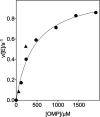Orotidine 5'-Monophosphate Decarboxylase: The Operation of Active Site Chains Within and Across Protein Subunits
- PMID: 32374983
- PMCID: PMC7476526
- DOI: 10.1021/acs.biochem.0c00241
Orotidine 5'-Monophosphate Decarboxylase: The Operation of Active Site Chains Within and Across Protein Subunits
Abstract
The D37 and T100' side chains of orotidine 5'-monophosphate decarboxylase (OMPDC) interact with the C-3' and C-2' ribosyl hydroxyl groups, respectively, of the bound substrate. We compare the intra-subunit interactions of D37 with the inter-subunit interactions of T100' by determining the effects of the D37G, D37A, T100'G, and T100'A substitutions on the following: (a) kcat and kcat/Km values for the OMPDC-catalyzed decarboxylations of OMP and 5-fluoroorotidine 5'-monophosphate (FOMP) and (b) the stability of dimeric OMPDC relative to the monomer. The D37G and T100'A substitutions resulted in 2 kcal mol-1 increases in ΔG† for kcat/Km for the decarboxylation of OMP, while the D37A and T100'G substitutions resulted in larger 4 and 5 kcal mol-1 increases, respectively, in ΔG†. The D37G and T100'A substitutions both resulted in smaller 2 kcal mol-1 decreases in ΔG† for the decarboxylation of FOMP compared to that of OMP. These results show that the D37G and T100'A substitutions affect the barrier to the chemical decarboxylation step while the D37A and T100'G substitutions also affect the barrier to a slow, ligand-driven enzyme conformational change. Substrate binding induces the movement of an α-helix (G'98-S'106) toward the substrate C-2' ribosyl hydroxy bound at the main subunit. The T100'G substitution destabilizes the enzyme dimer by 3.5 kcal mol-1 compared to the monomer, which is consistent with the known destabilization of α-helices by the internal Gly side chains [Serrano, L., et al. (1992) Nature, 356, 453-455]. We propose that the T100'G substitution weakens the α-helical contacts at the dimer interface, which results in a decrease in the dimer stability and an increase in the barrier to the ligand-driven conformational change.
Conflict of interest statement
The authors declare no competing financial interest.
Figures











Similar articles
-
Protein-Ribofuranosyl Interactions Activate Orotidine 5'-Monophosphate Decarboxylase for Catalysis.Biochemistry. 2021 Nov 16;60(45):3362-3373. doi: 10.1021/acs.biochem.1c00589. Epub 2021 Nov 2. Biochemistry. 2021. PMID: 34726391 Free PMC article.
-
Rate and Equilibrium Constants for an Enzyme Conformational Change during Catalysis by Orotidine 5'-Monophosphate Decarboxylase.Biochemistry. 2015 Jul 28;54(29):4555-64. doi: 10.1021/acs.biochem.5b00591. Epub 2015 Jul 14. Biochemistry. 2015. PMID: 26135041 Free PMC article.
-
Role of the Carboxylate in Enzyme-Catalyzed Decarboxylation of Orotidine 5'-Monophosphate: Transition State Stabilization Dominates Over Ground State Destabilization.J Am Chem Soc. 2019 Aug 28;141(34):13468-13478. doi: 10.1021/jacs.9b04823. Epub 2019 Aug 14. J Am Chem Soc. 2019. PMID: 31365243 Free PMC article.
-
Orotidine 5'-Monophosphate Decarboxylase: Probing the Limits of the Possible for Enzyme Catalysis.Acc Chem Res. 2018 Apr 17;51(4):960-969. doi: 10.1021/acs.accounts.8b00059. Epub 2018 Mar 29. Acc Chem Res. 2018. PMID: 29595949 Free PMC article. Review.
-
Catalysis by enzyme conformational change as illustrated by orotidine 5'-monophosphate decarboxylase.Curr Opin Struct Biol. 2003 Apr;13(2):184-92. doi: 10.1016/s0959-440x(03)00041-1. Curr Opin Struct Biol. 2003. PMID: 12727511 Review.
Cited by
-
The Role of Asn11 in Catalysis by Triosephosphate Isomerase.Biochemistry. 2023 Jun 6;62(11):1794-1806. doi: 10.1021/acs.biochem.3c00133. Epub 2023 May 10. Biochemistry. 2023. PMID: 37162263 Free PMC article.
-
Kinetics and mechanism for enzyme-catalyzed reactions of substrate pieces.Methods Enzymol. 2023;685:95-126. doi: 10.1016/bs.mie.2023.03.002. Epub 2023 Apr 18. Methods Enzymol. 2023. PMID: 37245916 Free PMC article.
-
Enabling Role of Ligand-Driven Conformational Changes in Enzyme Evolution.Biochemistry. 2022 Aug 2;61(15):1533-1542. doi: 10.1021/acs.biochem.2c00178. Epub 2022 Jul 13. Biochemistry. 2022. PMID: 35829700 Free PMC article. Review.
-
Utilization of Cofactor Binding Energy for Enzyme Catalysis: Formate Dehydrogenase-Catalyzed Reactions of the Whole NAD Cofactor and Cofactor Pieces.Biochemistry. 2023 Aug 1;62(15):2314-2324. doi: 10.1021/acs.biochem.3c00290. Epub 2023 Jul 18. Biochemistry. 2023. PMID: 37463347 Free PMC article.
-
Protein-Ribofuranosyl Interactions Activate Orotidine 5'-Monophosphate Decarboxylase for Catalysis.Biochemistry. 2021 Nov 16;60(45):3362-3373. doi: 10.1021/acs.biochem.1c00589. Epub 2021 Nov 2. Biochemistry. 2021. PMID: 34726391 Free PMC article.
References
-
- Miller B. G.; Hassell A. M.; Wolfenden R.; Milburn M. V.; Short S. A. (2000) Anatomy of a proficient enzyme: the structure of orotidine 5′-monophosphate decarboxylase in the presence and absence of a potential transition state analog. Proc. Natl. Acad. Sci. U. S. A. 97, 2011–2016. 10.1073/pnas.030409797. - DOI - PMC - PubMed
-
- Tsang W.-Y.; Wood B. M.; Wong F. M.; Wu W.; Gerlt J. A.; Amyes T. L.; Richard J. P. (2012) Proton Transfer from C-6 of Uridine 5′-Monophosphate Catalyzed by Orotidine 5′-Monophosphate Decarboxylase: Formation and Stability of a Vinyl Carbanion Intermediate and the Effect of a 5-Fluoro Substituent. J. Am. Chem. Soc. 134, 14580–14594. 10.1021/ja3058474. - DOI - PMC - PubMed
MeSH terms
Substances
Grants and funding
LinkOut - more resources
Full Text Sources
Miscellaneous

